In the world of welding, there are several types of defects that may impact the strength or longevity of a weld. One such challenge is weld porosity. Today we will talk a bit about what weld porosity is, the causes and methods of prevention. Read on to learn more!
What is Weld Porosity?
When gas is trapped beneath the surface of a weld and then released from the weld pool, it leaves behind a weld defect. Those cavities are what the welding world refer to as porosity. There are several common forms of porosity, including wormholes, surface-breaking pores, distributed porosity and crater pipes.

Causes of Porosity
Weld porosity occurs when gasses impact the quality of the weld. The three specific gasses that cause this are hydrogen, oxygen and/or nitrogen. Science and decades of experience has taught the community of welders that this happens because of two key reasons:
- Oxygen and Nitrogen absorption is caused by improper gas shielding. This may be due to a variety of reasons. Common conditions include excessive gas flow rates, high speed winds, low gas flow rate or even nozzle seal failure.
- Hydrogen absorption is caused by the joint or filler/electrode having foreign matter on its surface. Often the foreign material is moisture. It can also be oil, rust, grease or paint as well.
While not all porosity is cause for concern, it is important to be aware of the causes. It’s also essential to reference set welding code acceptance criteria to establish which cases of porosity require repair.
Porosity Prevention
Thankfully, most weld porosity is preventable with just a few simple tweaks of equipment or technique. Being proactive about prevention steps will reduce overall waste and improve the quality of weld being produced. The following are Bancroft Engineering’s top tips for porosity prevention:
- Degrease and clean weld surface
- Ensure weld surface is thoroughly dried
- Inspect surface for coatings and remove if possible
- Reduce the possibility of high winds and/or drafts in welding environments
- Check welding equipment to ensure gas flow is at the recommended level
- Inspect the filler metal if used for cleanliness from possible corrosion and contamination
Another method for reducing weld porosity is with the use of robotic welding. Robotic welding offers a streamlined, consistent weld every time. Investing in automated welding will not only improve your product but it will also offer your team enhanced safety and the satisfaction of increased productivity.
Robotic Welding
Looking to optimize your welding process with improved efficiency and a stronger end-product? Our team of engineers have experience designing completely customized automated welding systems or semi-automated solutions to fit your needs. Get in touch today to learn more about how we can help you reduce porosity and increase productivity!



